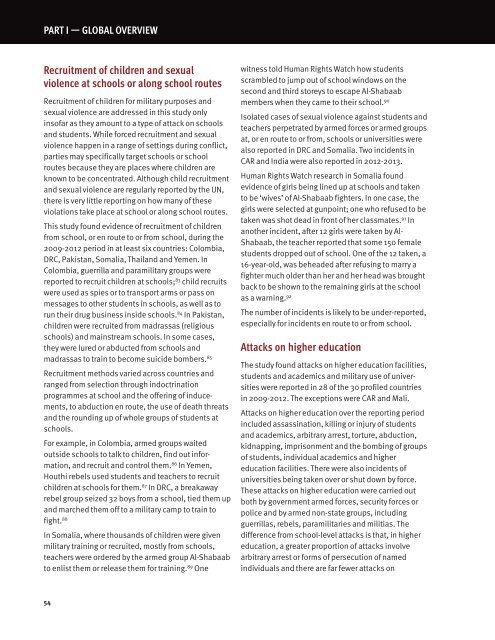Create successful ePaper yourself
Turn your PDF publications into a flip-book with our unique Google optimized e-Paper software.
PART I — GLOBAL OveRvIeW<br />
Recruitment of children and sexual<br />
violence at schools or along school routes<br />
Recruitment of children for military purposes and<br />
sexual violence are addressed in this study only<br />
insofar as they amount to a type of attack on schools<br />
and students. While forced recruitment and sexual<br />
violence happen in a range of settings during conflict,<br />
parties may specifically target schools or school<br />
routes because they are places where children are<br />
known to be concentrated. Although child recruitment<br />
and sexual violence are regularly reported by the UN,<br />
there is very little reporting on how many of these<br />
violations take place at school or along school routes.<br />
This study found evidence of recruitment of children<br />
from school, or en route to or from school, during the<br />
2009-2012 period in at least six countries: Colombia,<br />
DRC, Pakistan, Somalia, Thailand and Yemen. In<br />
Colombia, guerrilla and paramilitary groups were<br />
reported to recruit children at schools; 83 child recruits<br />
were used as spies or to transport arms or pass on<br />
messages to other students in schools, as well as to<br />
run their drug business inside schools. 84 In Pakistan,<br />
children were recruited from madrassas (religious<br />
schools) and mainstream schools. In some cases,<br />
they were lured or abducted from schools and<br />
madrassas to train to become suicide bombers. 85<br />
Recruitment methods varied across countries and<br />
ranged from selection through indoctrination<br />
programmes at school and the offering of inducements,<br />
to abduction en route, the use of death threats<br />
and the rounding up of whole groups of students at<br />
schools.<br />
For example, in Colombia, armed groups waited<br />
outside schools to talk to children, find out information,<br />
and recruit and control them. 86 In Yemen,<br />
Houthi rebels used students and teachers to recruit<br />
children at schools for them. 87 In DRC, a breakaway<br />
rebel group seized 32 boys from a school, tied them up<br />
and marched them off to a military camp to train to<br />
fight. 88<br />
In Somalia, where thousands of children were given<br />
military training or recruited, mostly from schools,<br />
teachers were ordered by the armed group Al-Shabaab<br />
to enlist them or release them for training. 89 One<br />
witness told Human Rights Watch how students<br />
scrambled to jump out of school windows on the<br />
second and third storeys to escape Al-Shabaab<br />
members when they came to their school. 90<br />
Isolated cases of sexual violence against students and<br />
teachers perpetrated by armed forces or armed groups<br />
at, or en route to or from, schools or universities were<br />
also reported in DRC and Somalia. Two incidents in<br />
CAR and India were also reported in 2012-2013.<br />
Human Rights Watch research in Somalia found<br />
evidence of girls being lined up at schools and taken<br />
to be ‘wives’ of Al-Shabaab fighters. In one case, the<br />
girls were selected at gunpoint; one who refused to be<br />
taken was shot dead in front of her classmates. 91 In<br />
another incident, after 12 girls were taken by Al-<br />
Shabaab, the teacher reported that some 150 female<br />
students dropped out of school. One of the 12 taken, a<br />
16-year-old, was beheaded after refusing to marry a<br />
fighter much older than her and her head was brought<br />
back to be shown to the remaining girls at the school<br />
as a warning. 92<br />
The number of incidents is likely to be under-reported,<br />
especially for incidents en route to or from school.<br />
Attacks on higher education<br />
The study found attacks on higher education facilities,<br />
students and academics and military use of universities<br />
were reported in 28 of the 30 profiled countries<br />
in 2009-2012. The exceptions were CAR and Mali.<br />
Attacks on higher education over the reporting period<br />
included assassination, killing or injury of students<br />
and academics, arbitrary arrest, torture, abduction,<br />
kidnapping, imprisonment and the bombing of groups<br />
of students, individual academics and higher<br />
education facilities. There were also incidents of<br />
universities being taken over or shut down by force.<br />
These attacks on higher education were carried out<br />
both by government armed forces, security forces or<br />
police and by armed non-state groups, including<br />
guerrillas, rebels, paramilitaries and militias. The<br />
difference from school-level attacks is that, in higher<br />
education, a greater proportion of attacks involve<br />
arbitrary arrest or forms of persecution of named<br />
individuals and there are far fewer attacks on<br />
54



